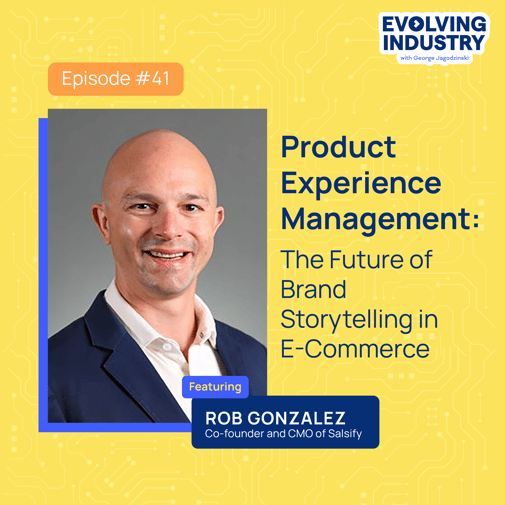Evolving Industry
Brand storytelling is sometimes an afterthought in syndicated product information management (PIM) strategies.
But Rob Gonzalez, Co-founder and CMO of Salsify, believes brand storytelling is a cornerstone of product experience management (PXM).
As more consumers step away from traditional marketing channels like cable television, Rob believes retailers need to meet them at the digital shelves — their product detail pages.
In this episode, we talked about:
- New challenges facing brand storytellers in e-commerce
- Overcoming friction points for new product launches
- How AI will factor into the future of brand storytelling
New Brand Storytelling Challenges in E-Commerce
A decade ago, many big-name retailers and manufacturers had a minimal online presence. But as Rob pointed out, we’re in an online shoppers’ world now.
“Over 10 years, that's changed dramatically, and you saw branded manufacturers go through a whole evolution of organization shifts to accommodate the growth in e-commerce,” he said.
Today, as many cord-cutting Americans now entertain themselves on digital-first mediums, marketers have to pivot to get their products’ stories in front of people. That means meeting customers where they are — online storefronts.
“In the world of the digital shelf, your brand and your product’s value [are] expressed through product detail pages everywhere on the internet,” Rob said.
Of course, these dramatic shifts brought new hurdles for marketing teams, one of them being decentralized product details across multiple digital channels. These deviations can often lead to substantial chargebacks and other quality issues.
Rob believes that’s a big problem for e-commerce brands because consistency is key to building a relationship with customers.
“Centralization is the true foundation for being able to tell a true brand story on product detail pages,” he said.
That’s why he thinks the most successful companies need marketing teams who are fully engaged in their e-commerce strategy if they want their products to stand out from the crowd.
“When you're talking about the brand team being engaged, I think that it's the most digitally mature companies where that's the most true,” Rob argued. “There are plenty of places where the brand team is not really paying that much attention to the product detail pages, not really heavily engaged in the retail media strategy, and missing opportunities to tell the story that they could tell.”
Fight the Friction in New Product Launches
A new product launch can be both exciting and terrifying, especially when dealing with multiple distribution partners.
It’s also another reason why centralized product data is so important, as Rob mentioned when sharing a story about a client.
“[They] had 700 distribution partners in the United States,” he said. “And for a new product to go live across all the distribution partners, it would take them over four months just because of the clerical work to set up the product for sale in all of the different purchase systems [for] all of their distribution partners.”
But through optimized product data exchanges with distributors, companies can drastically reduce launch windows.
“You can bring that from over four months down to a week, two weeks, by centralizing the requirements of all those downstream channels and making sure that you're collecting all that information upfront,” Rob said. “So when you're ready to launch the product, you're ready to launch the product.”
Rob believes that’s one of the big advantages that a PXM strategy has in today’s fast-moving e-commerce space.
“There’s cost savings, operational effectiveness, and sales growth all seen from that investment.”
AI and the Future of Brand Storytelling
We’re rounding into 2024 at the time of this writing, and lots of brands are going all in on automation and AI technologies.
“We're seeing already that the automation of task completion by bots is overwhelming the task completion by humans in the system,” Rob said. “So you get a lot of leverage on your investment through that now with AI.”
However, Rob and the folks at Salsify aren’t using these tools for content generation, but to weed menial tasks from their workflows.
“Where we're going is not the content generation angle,” he said. “AI should allow you to automate a significant amount of tasks that are currently hard to automate using just regular bots.”
But that doesn't mean AI doesn't have a place in the grand scheme of brand storytelling in a PXM strategy.
For example, Rob talked about how some retailers have updated their product content style guidelines to disallow particular verbiage.
“One statement is you cannot make any maximalist claims in your product description,” he said. “A maximalist claim would be something like ‘the most healthy, the best selling, the most popular, number one recommended,’ like all of that stuff. They're saying, ‘Don't put that in the product description.’”
So Rob’s team has been training their AI models to catch these claims in their clients’ product descriptions.
“That's just one validation example, but we found a ton of those types of examples where you can not only validate and find the mistake but have the system propose a correction and then have that correction approved by a human.”
Perhaps it's needless to say that Rob’s outlook on AI’s potential to give marketers their time back is a positive one.
“It’s not an insignificant amount of time savings and operational efficiency boosting that you can get from those types of investments.”
Craving more? You can find this interview and many more by subscribing to Evolving Industry on Apple Podcasts, on Spotify, or here.
